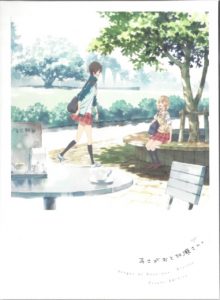 1.Introduction
1.Introduction
When Pure Yuri Anthology Hirari magazine, Volume 2 hit shelves in summer 2010, it didn’t have any big names in Yuri in the table of contents. (Hakamada Mera did not join the roster until Volume 3, and Morinaga Milk would follow in 2012.) Many of the names who joined in subsequent volumes had not yet become familiar to readers, but would as a result of their work in this magazine. In fact, looking over the author’s notes at the end of the magazine, several of the notes mention that this is the creators first time attempting a Yuri story. Among these new names was Takashima Hiromi, an artist who had been recruited by Shinsokan at a doujinshi event. Having done BL and straight pairings, her editor asked her if she’d do a story for a new Yuri magazine.
And so, in August 2010, a story called Asagao to Kase-san. (あさがおと加瀬さん) made its debut in Pure Yuri Anthology Hirari magazine. The magazine favored stories set during school years. When compared to the Comic Yuri Hime issues at the time, the difference was a little stark. This was the same summer Morishima Akiko was writing Renai Joshika, about women who worked at a marriage planning company, complete with lesbian identity expressed through the use of queer slang. In comparison, Hirari stories seemed rather bland.
2. What is “Pure” Yuri anyway..?
In this post-Maria-sama ga Miteru “S”-scented environment, we were introduced to Yamada, a high school girl who takes care of the school grounds and Kase-san, the school track star. Yamada, we learn, has somewhat low self-esteem, not helped by the people around her, who have limited expectations for her. The story, told from Yamada’s perspective, follows her interest in Kase-san as an object of romantic affection, then a partner in an emotional romantic, then physical, relationship through their high school years. We follow Yamada as she deals with the feelings of love and attraction – and we get constant reminders that Kase-san is not 100% confident and assured, either. She, too, is a teenaged girl and not quite sure she’s doing any of this right.
Although none of the three Yuri manga magazines being published by 2011 were in any way pornographic, Hirari was the most sexless. Despite the stated “purity” of the Yuri, readers are given plenty of fanservice – especially in early chapters – in the form of underwear and changing scenes. “Pure” could, of course refer to the “S” aesthetic of passionate platonic romance. Takashima-sensei took to asking herself and the readers “What does “Pure” Yuri mean, anyway?” in her author’s comments in each volume.
Regardless of what the publisher may have meant, fans of the Kase-san series found the relationship between Yamada and Kase-san to be realistic. Awkward, gentle, with bumps in the road from jealousy, self-esteem, body issues, boundaries, we see both Yamada and Kase-san mature over time both as individuals and together as a couple, in a world peopled with friends and teammates, classmates, teachers and parents.
3. To Be Continued..
 By the time the magazine ceased publication in 2014, Kase-san had become one of the most popular series. That year, the second volume, Obentou to Kase-san. was awarded the #1 Yuri Manga of the Year on Okazu. In my end-of-year write up I said of this volume:
By the time the magazine ceased publication in 2014, Kase-san had become one of the most popular series. That year, the second volume, Obentou to Kase-san. was awarded the #1 Yuri Manga of the Year on Okazu. In my end-of-year write up I said of this volume:
Sure, it’s the same old story, but without being creepy or trite, without featureless moe faces, or featureless Yuri romance. Kase and Yamada’s romance is adorable and we can watch it develop without feeling like sick voyeurs, more like the adults we are, merely happy to see the children so happy together.
Although the magazine was no longer in print, the publishers continued several series online in order to wrap up final volumes. Shortcake to Kase-san. (ショートケーキと加瀬さん。) was published in 2015, ending the story begun in the magazine. And, it would seem, that the series was done. With no place to publish, we might have expected to never hear of Yamada or Kase-san again.
Except…Takashima Hiromi is an exceptional manga artist. In conversation with her at TCAF 2019, she expressed complete confidence in her abilities to tell a story. When the magazine ceased publication, she took the Kase-san series online and sold individual chapters on the various online manga platforms such as Yahoo Comics (on the Japanese version of the portal platform; there is no western equivalent), the social SNS platform LINE, and later on the publisher’s online version of their leading magazine, Wings, Web Wings. In 2017, the 4th volume, Apron to Kase-san. (エプロンと加瀬さん。) was published in Japanese. The publisher was still in Takashima’s corner. With the publication of that 4th volume came an avalanche of events.
In 2017, Kase-san and Morning Glories made its English-language debut from Seven Seas Publishing. This has been followed by translations into French and German and Polish. That same year, animation studio Pony Canyon launched a video clip on Youtube; a 6-minute music video, Kimi no Hikari (キミノヒカリ). In English and Japanese, with promotion in both languages, on all their social media platforms, Pony Canyon teased that if they got 100,000 views on the video, that they’d consider something more. When the number was reached, Pony Canyon did indeed come up with a stunning announcement – Asagao to Kase-san would be getting an animated OVA, to be released in Japanese theaters.
In summer 2018, Asagao to Kase-san‘s national roadshow took it through theaters for 2 and half months, an almost unheard of length of time for an animated feature. That OVA was shown in America at Anime Expo 2018 and AnimeNYC 2018. In Q&A sessions at AnimeNYC with the Producer and Director, Satou and Terada both expressed that for them, the importance of the story was not “two girls fall in love,” but what a relationship looks like as it develops and how communication is what helps it grow.
 2018 continued to be a good year for the series. 8 years after we first had met Yamada and Kase-san, they finally reached high school graduation. With the publication of Sakura to Kase-san (さくらと加瀬さん。) the two we’d followed for so many years entered college in Tokyo and slept together for the first time, bringing the story once and for all out of the realm of imagined purity (although, in her author’s notes at the end of the volume, Takashima’s avatar once again asked “what exactly is “Pure” Yuri, anyway?” as she had in the previous volumes.) Also in 2018, the Kase-san series premiered in the print edition of the Shinsokan flagship manga magazine, Wings.
2018 continued to be a good year for the series. 8 years after we first had met Yamada and Kase-san, they finally reached high school graduation. With the publication of Sakura to Kase-san (さくらと加瀬さん。) the two we’d followed for so many years entered college in Tokyo and slept together for the first time, bringing the story once and for all out of the realm of imagined purity (although, in her author’s notes at the end of the volume, Takashima’s avatar once again asked “what exactly is “Pure” Yuri, anyway?” as she had in the previous volumes.) Also in 2018, the Kase-san series premiered in the print edition of the Shinsokan flagship manga magazine, Wings.
In 2019, Takashima-sensei was a guest at Toronto Comic Arts Festival. She spoke with quiet confidence about her work and about the evolution of the series. Watching Yamada grow, and both she and Kase-san develop in their relationship, was the point for her. With both Yamada and Kase-san now grown up and starting to face more adult life. she stated that we should expect to see their relationship to develop as well.
This little story about two high school girls, a story that as a “Story A”, one might have expected to have finished and been forgotten, has thrived both online and in print. The Kase-san series can be seen as emblematic of Yuri as a whole – persevering when no one cared, now thriving in the current environment. Kase-san has been the “little series that could” and as we look forward to the 6th volume of the series, the upcoming Yamada to Kase-san (山田と加瀬さん。) , we can feel pride in its success. We could do worse for ambassadors of Yuri, energetically leading us forward into the next 100 years.
![]() Yamada and Kase-san have officially begun their lives as college students in the big city. It’s a life full of challenges; getting around, meeting people, balancing their relationship and the physical distance separating them against the rest of their lives.
Yamada and Kase-san have officially begun their lives as college students in the big city. It’s a life full of challenges; getting around, meeting people, balancing their relationship and the physical distance separating them against the rest of their lives.

